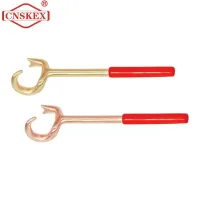Your Position: Home - Hand Tools - Use and management of explosion-proof tools
Explosion-proof tools are spark-free tools, which refer to tools used in flammable and explosive dangerous places. They are characterized by explosion-proof performance and can effectively avoid fire or explosion caused by static electricity, sparks and other factors. The scope of use of explosion-proof tools is very wide, including petrochemical, coal mining, fertilizer, printing and dyeing, pharmaceutical, food and other industries. In these places, the use of explosion-proof tools is indispensable. In short, the use of explosion-proof tools must comply with the provisions of national standards and industry standards to ensure safe and reliable use.
Explosion-proof tools are a special safety special tool, which has the characteristic of not generating sparks when the tool collides and rubs with the workpiece.
Most varieties and specifications are evolved from steel tools, but the material is made of multi-element non-ferrous metals with copper as the base, and some products are specially designed.
Therefore, there are certain requirements for usage methods, maintenance, storage and transportation.
Only by fully understanding, reasonably selecting, correctly using and keeping it can the advantages of its various performances be fully utilized.
Therefore, users should strictly abide by the following precautions.
(1) Non-sparking Safety Tools are a kind of safety protection products, so users must purchase products that have been tested and certified by nationally recognized explosion-proof performance testing units.

When purchasing, you must carefully understand the applicable scope, performance, characteristics, usage methods and precautions specified in the manual.
In addition, the tool body is usually marked with the "Ex" mark and has a certificate of conformity.
Tools without the mark should not be purchased and used casually.
(2) Before using explosion-proof tools, the flammable gas in the workplace should be compared with the explosion-proof test gas; products that have passed the test with a higher level of medium can be used in places with a lower level of danger.
Conversely, products that have passed the test with a lower level of medium cannot be used in places with a higher level of danger. If there is a special need, please ask the manufacturer to go to the testing unit for testing before using it.
Obviously, it should not be used as an ordinary tool in non-hazardous places to avoid losing its proper performance.
It should also be pointed out that it should not be used as a substitute at will. If the current product specifications cannot meet the user's needs, special design and manufacturing should be applied for.
(3) Explosion-proof media are high-strength and corrosion-resistant in most media gases.
However, it is not corrosion-resistant in all cases. For example, in wet ammonia, certain ammonium salts, acetylene, wet fluorine, chlorine, chromium ammonium, certain dichromates, potassium hydride and other media, the degree of corrosion is quite large.
Moreover, some media will react chemically with copper alloys to produce highly dangerous explosive substances, such as acetylene steel produced by the combination of acetylene and steel.
Therefore, when using Non-sparking tools, try to use them in a dry environment. If it is impossible to avoid using them in a wet environment, try to speed up the operation and reduce the working time to avoid causing greater corrosion and danger.
Wipe them clean at any time after use, and it is strictly forbidden to store them together with corrosive media.
(4) Various types of wrenches of explosion-proof hand tools have different rated strengths. It is strictly forbidden to use them with overload sleeves. Except for knocking wrenches, they must not be knocked to avoid overload fracture and deformation, which will affect normal use.
When using tools, you should choose the type and specification of tools according to your needs. You should not use a small tool instead of a large one, and you should not treat it as a steel tool. It should also be pointed out that when using adjustable wrenches, pipe pliers, and fixed wrenches, you should pay attention to the requirements of the force direction and should not arbitrarily apply force in the opposite direction. When using tools with blades, you should first measure the hardness of the workpiece itself. If its hardness is close to the hardness of the tool, you should operate it carefully. If it is higher than the hardness of the tool, it is prohibited to use it.
When the workpiece is tightened by a motor, semi-permanently fixed, or rusted for a long time, and no other measures are taken before using manual tools, it should be prohibited to use it to avoid damaging the tool.
(5) After explosion-proof safety tools are out of use, they should be wiped clean at any time. If they are not used within half a year, they should be oiled or preserved by anti-corrosion methods. If they are out of use for more than one year, they should be oiled and stored in bags or boxes.
For used tools, some parts are naturally worn or damaged, especially tools with blades. They can be repaired in non-hazardous places.
If the damage and wear are serious and it is not suitable for self-repair, they should be scrapped and not operated with defects.
92
0
0
Comments
All Comments (0)